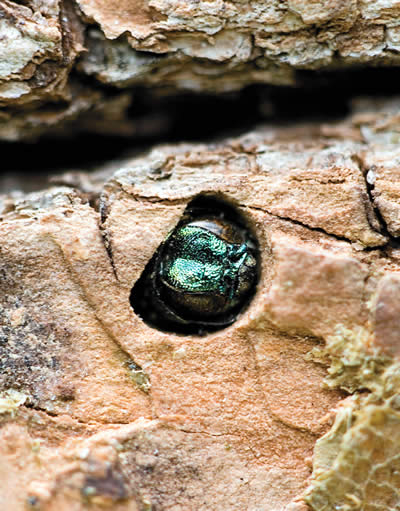
July 21, 2022 - The presence of the invasive emerald ash borer (EAB) has been confirmed in two additional Texas counties this month – Morris and Rusk. EAB is now confirmed in 11 Texas counties, five of those added just this year.
EAB is an invasive wood-boring pest of ash trees that has killed millions of trees across 35 states since its arrival to the United States in 2002.
“The pest is a major threat to urban, suburban and rural forests as it aggressively kills ash trees within two to three years after infestation,” said Demian Gomez, Texas A&M Forest Service Regional Forest Health Coordinator.
The beetle was first detected in Texas in 2016 in Harrison County. Since then, EAB has been confirmed in Bowie, Cass, Dallas, Denton, Marion, Morris, Rusk, Wise, Parker and Tarrant counties.
“The rapid spread of EAB will be detrimental to our ash tree population, potentially killing millions of trees as it spreads across Texas,” said Gomez. “The devastation of our ash tree population will have an economic impact of billions of dollars, alter forest structure and composition and negatively affect the animal communities that rely on the tree species to survive.”
Once beetles that matched the description for EAB were detected in Morris and Rusk counties, the specimens were sent to the USDA Animal and Plant Health Inspection Service (APHIS) lab for confirmation.
After confirmation from the lab, both counties were added to the list of Texas jurisdictions under quarantine by the Texas Department of Agriculture (TDA). TDA quarantines are designed to slow the spread of the insect pest by restricting movement of any woody ash material leaving the quarantined area.
“Because EAB is transported unintentionally on firewood and wood products, the quarantine helps slow the beetle’s spread by restricting the movement of wood in and out of affected areas,” said Gomez.
Each year, Texas A&M Forest Service sets traps and monitors for the pest from late winter to early summer.
“Early detection of the beetle is the best way to stop the spread and avoid high ash mortality,” said Gomez. “This year, we deployed 500 traps across Central, East and North Texas with 45 of them collecting EAB.”
All traps are being removed as EAB beetles only fly from April to June. Traps will be placed back in late winter of next year.
“As EAB spreads to new areas in Texas, it is important to recognize early signs and symptoms of attacked trees,” said Gomez.
While ash trees with low numbers of EAB often have few or no external symptoms, residents should look for signs of EAB among their ash trees for early detection. Symptoms typically include dead branches near the top of the tree, leafy shoots sprouting from the trunk, bark splits exposing S-shaped larval galleries, extensive woodpecker activity and D-shaped exit holes.
Communities and residents can find resources on identifying and managing EAB infestations and creating a community preparedness plan at http://texasforestservice.tamu.edu/eab/.
EAB photos and resources can be found at http://ow.ly/LIJi30lbBxz.
View the statewide summary of potential impacts of EAB at https://bit.ly/3zlJMcD.
For information from TDA on EAB quarantines, visit https://bit.ly/3INSlzV or https://bit.ly/3PzADlJ.
To report EAB, call 1-866-322-4512.








